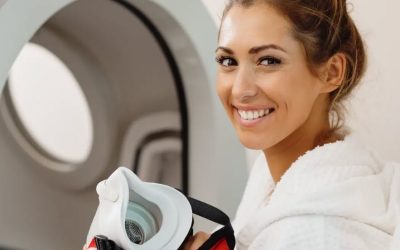WATCH INTERVIEW HEREIn an interview with HCPLive, Shai Efrati, MD, PhD, co-Founder and Chair of Aviv Scientific’s Medical Advisory Board, discussed the clinical significance of the results of his study that evaluated the efficacy of hyperbaric oxygen therapy for...
HBOT Protocol very effective for Fibromyalgia caused by TBI
Researchers from Tel Aviv University compared treatment with a dedicated protocol of hyperbaric oxygen therapy (HBOT) to the pharmacology (drugs) treatment available today for patients suffering from fibromyalgia as a result of a traumatic brain injury (TBI). The...
Hyperbaric Oxygen Therapy may Improve Pain, Fatigue in Patients with Fibromyalgia
Hyperbaric Oxygen Therapy may Improve Pain, Fatigue in Patients with Fibromyalgia Feb 5, 2023 Lana Pine The majority of included studies observed improvements in pain, fatigue, patient global, sleep disturbance, multidimensional function, and tender points. Hyperbaric...
HBOT clinic reports high success rate healing fibromyalgia patients
The Hyperbaric Medical Clinic (Estepona, Spain) is making headlines as they continue to show how hyperbaric oxygen is helping countless fibromyalgia patients improve their quality of life. Many patients diagnosed with fibromyalgia come to the Hyperbaric Medical Clinic...
Clinical Trial – Hyperbaric Oxygen Therapy Compared to Pharmaceutical in Fibromyalgia With Emotional Trauma
The investigators have previously studied the efficacy of hyperbaric oxygen therapy (HBOT) as
a treatment for Fibromyalgia syndrome (FMS) in a prospective, active control, crossover
clinical trial. The results demonstrated significant amelioration of all FMS symptoms, with
significant improvement in life quality; furthermore, the investigators were able to
demonstrate significant neuroplasticity on SPECT imaging, with a decrease of the
hyperactivity in posterior regions and elevation of the reduced activity in frontal areas.
In this study, the investigators intend to both repeat and expand the investigator’s previous
findings, treating FMS patients with history of emotional trauma with HBOT, while performing
an extensive of evaluation both before and after treatment.
In the current study, the investigators plan to compare HBOT to current standard of care of
FMS (pharmacological and non – pharmacological).
T helper 1 response is correlated with widespread pain, fatigue, sleeping disorders and the quality of life in patients with fibromyalgia and is modulated by hyperbaric oxygen therapy.
Abstract: Hyperbaric oxygen therapy (HBOT) has been used as treatment for different clinical conditions, including fibromyalgia (FM). HBOT modulates brain activity, ameliorates chronic pain and modifies the ratio of immune cells. Clinical studies have provided...
Clinical Trial – Transcranial Magnetic Stimulation and Hyperbaric Chamber for Women Fibromyalgia
Fibromyalgia syndrome (FMS) is a multisystem disease, characterized by generalized chronic
musculoskeletal pain. In addition, there is a lot of care for fatigue, sleep disorders,
morning stiffness, cognitive disorders, depression, anxiety and stress. Other common symptoms
are back pain, headaches, irritable bowel, balance problems and deterioration of physical
function in general. Patients with fibromyalgia (FM) often show pain at specific points that
are known as "tender spots or tender spots, with an increased sensitivity to painful stimuli"
(hyperalgesia) and a decreased pain threshold (allodynia). which can be evidenced in the
physical examination and in the absence of anomalies that justify in the biological or image
tests. These pain points to pressure, based on the most specific and specific criteria for
the diagnosis of the disease, traditionally based on the criteria of the American College of
Rheumatology (ACR), according to which, should be presented so minus 11 out of 18 painful
points to confirm it. Although the etiology remains unknown and unclear, its appearance is
attributed to a problem of central sensitization, that is, changes in central processing,
which causes an alteration of the mechanisms that regulate the sensation of pain, with
amplification of nociceptive input . and perpetuation of painful stimuli. Fibromyalgia is
becoming a common syndrome in the countries of Western Europe, with a prevalence in the
general population that ranges between 1-3%, and specifically in Spain, around 2.4%. In
addition, it has a higher incidence in women than men (73-95%), predominantly affecting women
between the ages of 40-50 years. About 3% of women with fibromyalgia are at an age when
menopause occurs, so not only do they experience the symptoms of both states but they even
exacerbate the syndrome with each other. On the other hand, and in relation to its
chronicity, the care of this type of patients involves large costs for society with a
significant consumption of health resources in the field of primary care, as well as the
costs of work absenteeism. For these reasons, it is considered an important problem with a
great impact on the health system, and therefore more and more studies are being developed
with the aim of better understanding the pathophysiology of this disease. The therapeutic
approach includes low cost and easy access measures, such as physical exercise (EF) programs
to improve the symptoms of FM. Physical exercise has positive effects directly on pain, joint
and muscle stiffness, generalized sensitivity and fatigue, among others, and secondarily on
cognitive disorders. Thus, the vast majority of studies focus on low-impact aerobic exercise,
performed between 60% and 70% of the maximum heart rate two to three times a week. However,
to date, there is no study that compares the effectiveness of physical exercise with other
innovative therapeutic actions, such as transcranial magnetic stimulation (TMS), the
hyperbaric chamber (HBOT), in parameters related to pain and quality of life. the life of
patients with fibromyalgia. The general objective is the effectiveness of transcranial
magnetic stimulation and the hyperbaric chamber in women with fibromyalgia. As specific
objectives we propose:
To assess the effect of HBOT, TMS and EF on quality of life in women with fibromyalgia.
– Object the effect of HBOT, TMS and EF in cortical functioning.
– Evaluate the effect of HBOT, TMS and EF on fatigue.
– Evaluate the effect of HBOT, TMS and EF on psychological aspects, such as depression and
anxiety.
– Evaluate the effect of HBOT, TMS and EF on the perception of pain and the number of
painful points.
– Evaluate the effect of HBOT, TMS and EF on the quality of sleep.
– Evaluate the effect of HBOT, TMS and EF on the quality of life.
– Evaluate the effect of HBOT, TMS and EF on the pain constructs.
– Determine the effect of HBOT, TMS and EF on plasma endorphin levels.
Clinical Trial – HBOT for Patients With IC/FM (Interstitial Cystitis/Fibromyalgia)
The investigators observed 12 fibromyalgia and interstitial cystitis patients undergoing
hyperbaric oxygen oxygen treatment in a multiplace pressure chamber for 90 minutes, 40
treatment each, using an oro-nasal mask.
Hyperbaric Oxygen Therapy Can Induce Neuroplasticity and Significant Clinical Improvement in Patients Suffering From Fibromyalgia With a History of Childhood Sexual Abuse-Randomized Controlled Trial.
Abstract: Fibromyalgia syndrome (FMS), a condition considered to represent a prototype of central sensitization syndrome, can be induced by different triggers including childhood sexual abuse (CSA). Recent studies have demonstrated hyperbaric oxygen therapy (HBOT) can...
Neuromuscular efficiency in fibromyalgia is improved by hyperbaric oxygen therapy: looking inside muscles by means of surface electromyography.
Abstract: Neuromuscular efficiency (NME) is impaired in fibromyalgia (FM). Hyperbaric oxygen therapy (HBOT) is a medical treatment using 100% of oxygen through an oxygen mask. HBOT in FM induces changes in cortical excitability and a secondary reduction in pain and...




